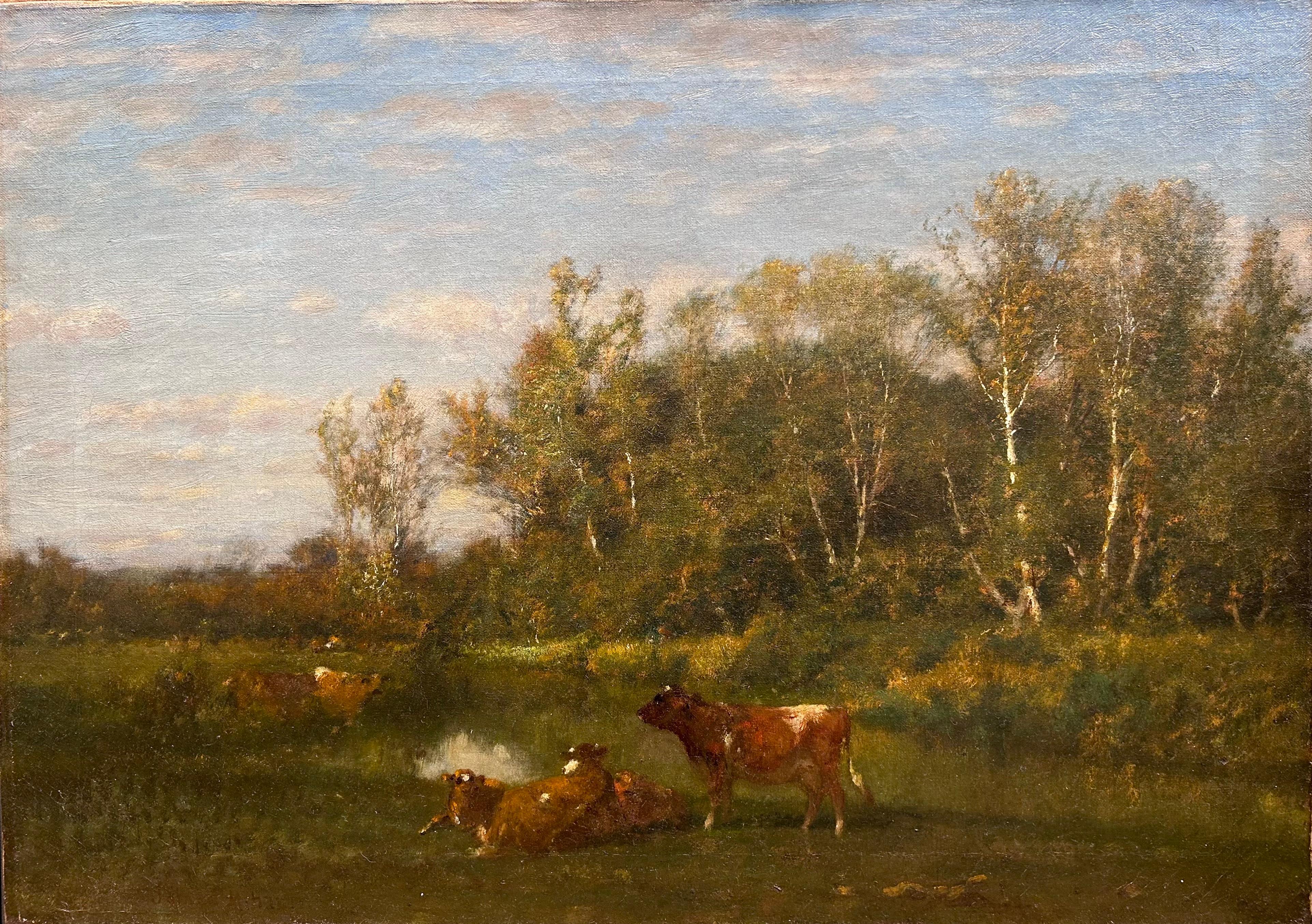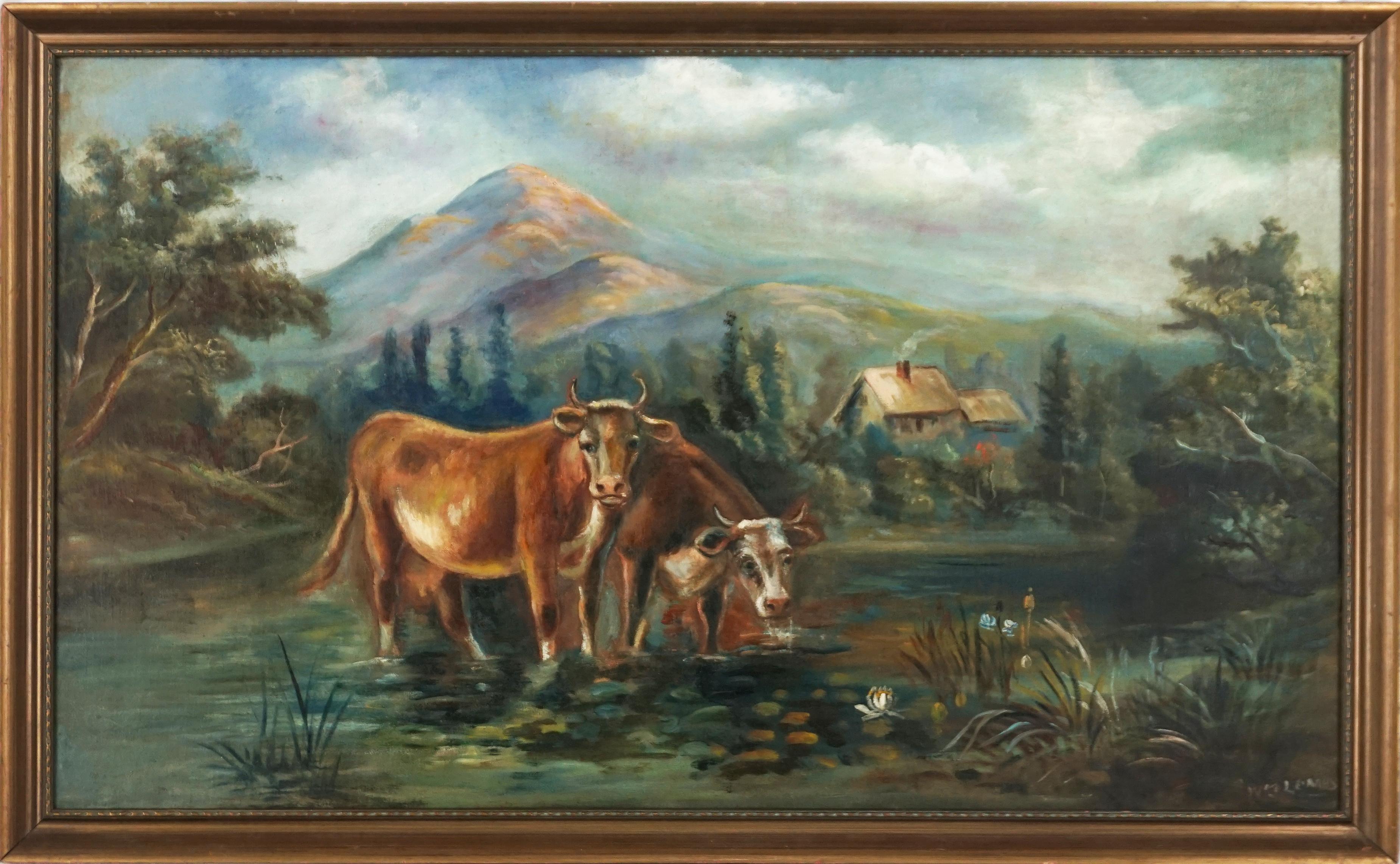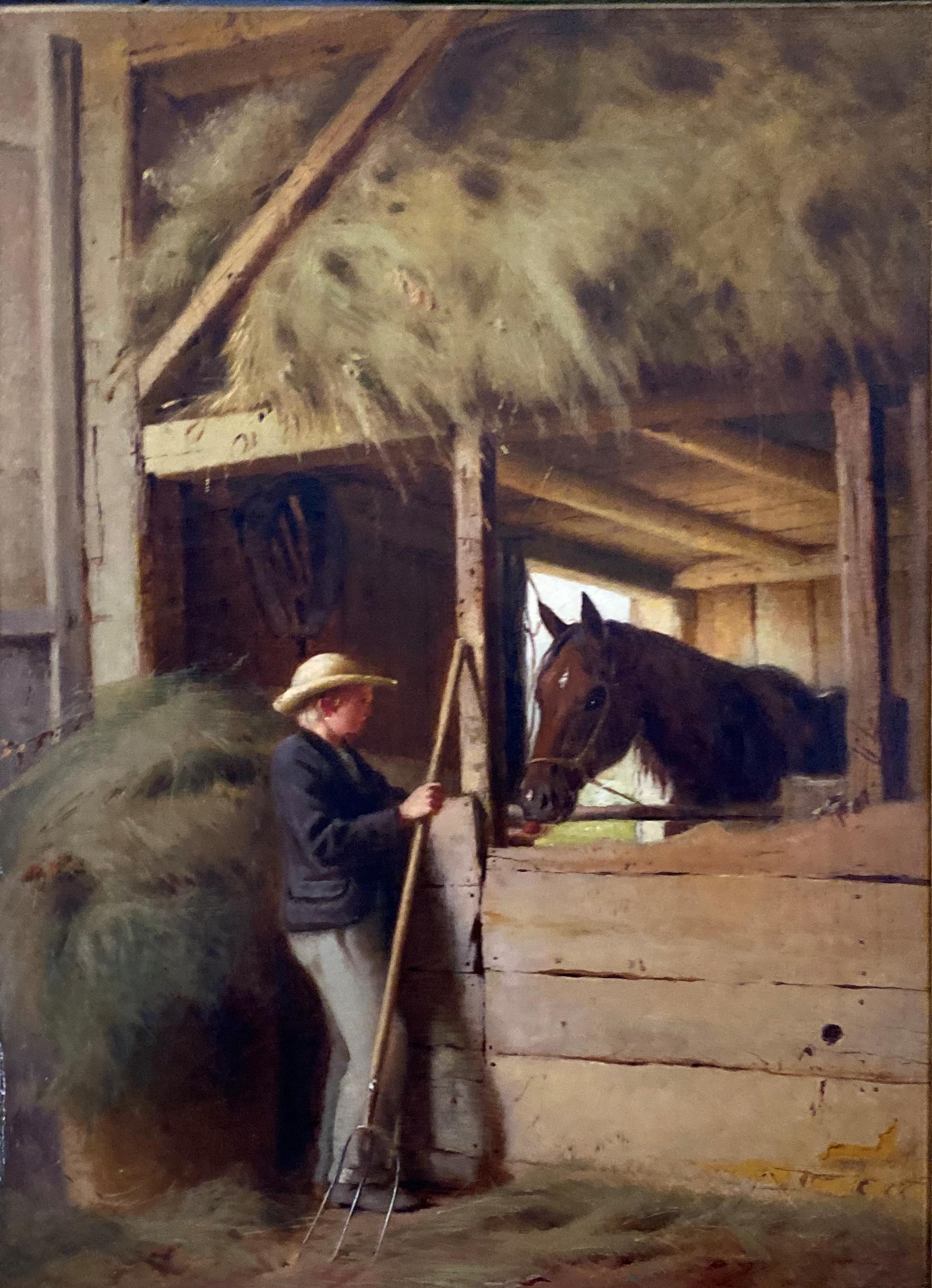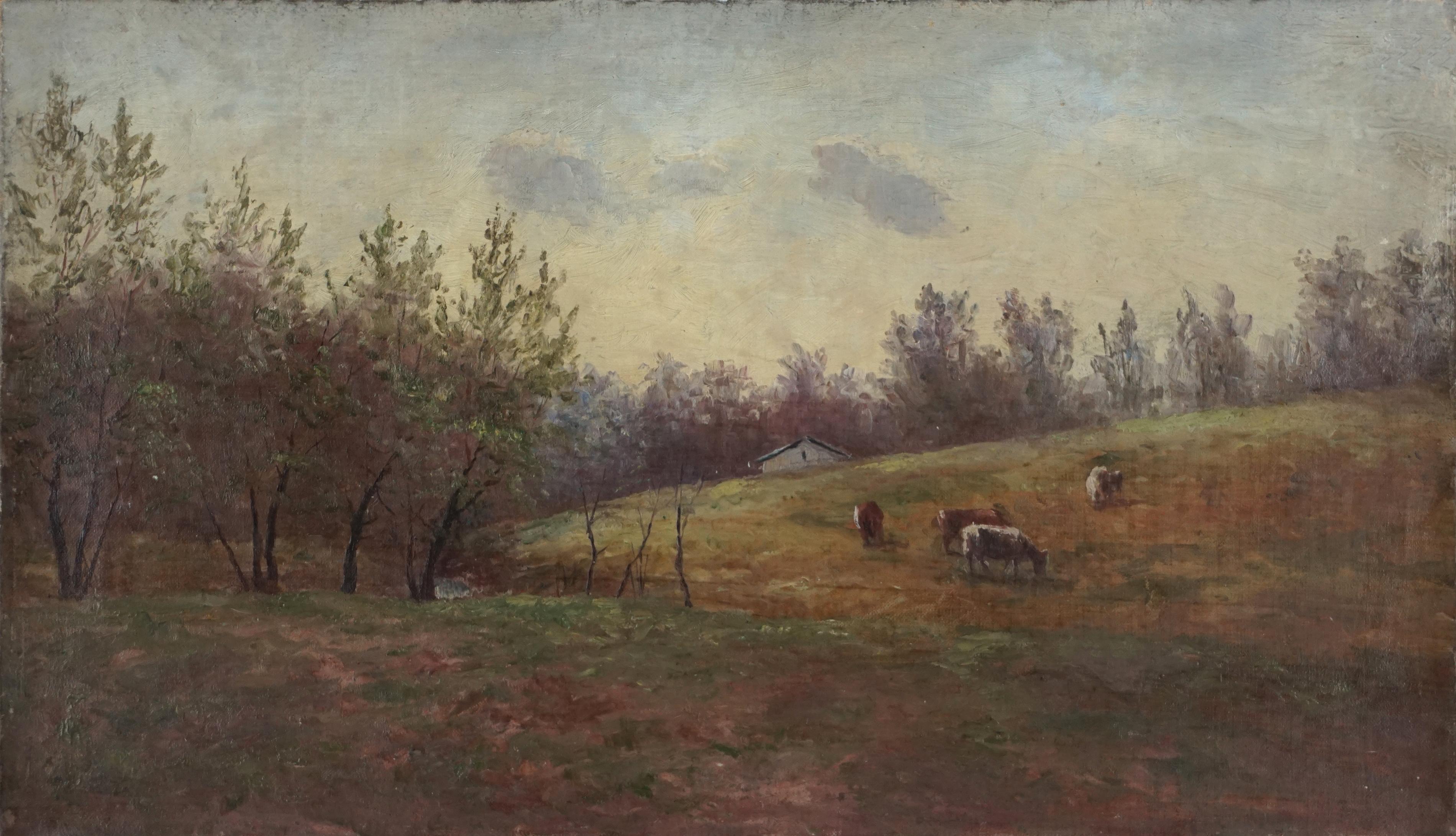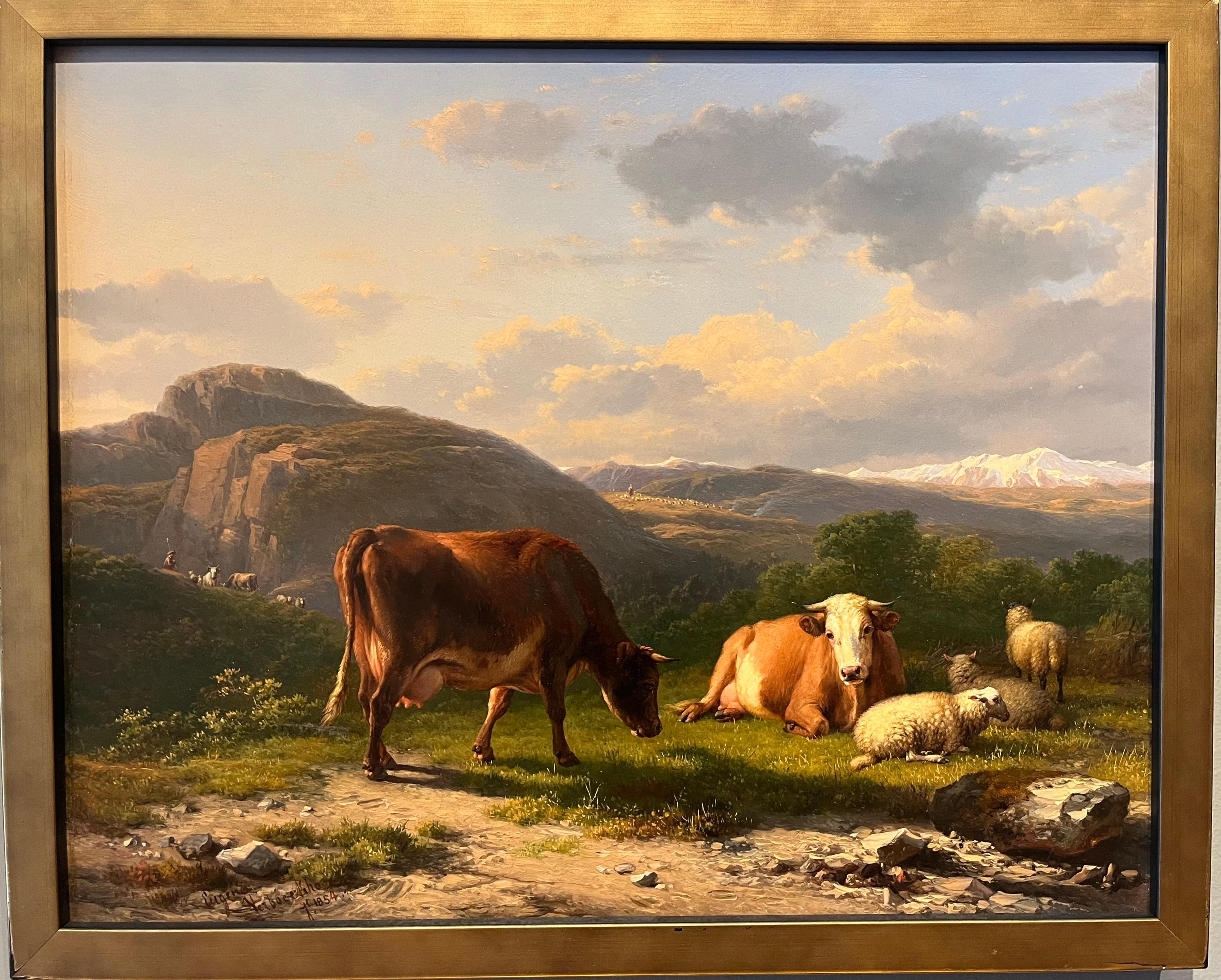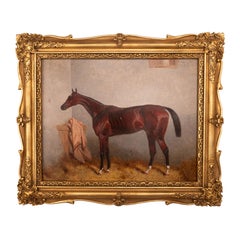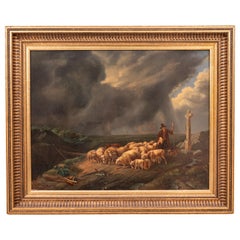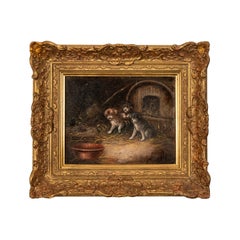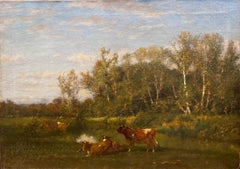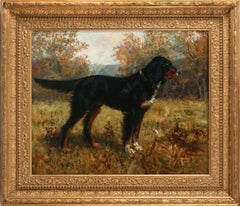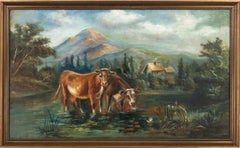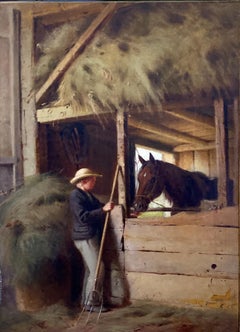Items Similar to Antique American Hudson River School Oil Painting Cows Landscape Troy New York
Want more images or videos?
Request additional images or videos from the seller
1 of 19
Charles Grant BeauregardAntique American Hudson River School Oil Painting Cows Landscape Troy New York1898
1898
About the Item
A rather beautiful Hudson River landscape oil on canvas painting by the celebrated New York artist Charles Grant Beauregard (1856-1919), signed and dated 1898.
The painting depicts cows in a bucolic landscape standing on the banks of the tree-lined river with a figure walking down the path behind the cows, the painting depicts both banks of the river, the opposite bank with two farmhouses, the location is most likely the Western edge of Troy with the hills behind to the East.
The painting is signed "C. G. Beauregard 98" lower left, it is housed in the orinal gilded frame, label to the verso "Annesle & Co Albany Art Gallery". Condition is very good, this rather beautiful & calm painting is ready to hang on your wall.
At sight without frame 24" x 18"
Charles Grant Beauregard was a talented landscape painter associated with the Hudson River School. Somewhat in the manner of George Inness (American, 1825–1874). Charles Grant Beauregard was born in Montreal, Quebec, Canada, but found himself in Troy, New York in 1872. He apparently found the area to his liking and remained there until his death in 1919, with only a brief return to Montreal circa 1876 to 1880.
Although Beauregard initially specialized in portraiture; as Troy is located on the Hudson River, he was no doubt inspired by the natural beauty of the Hudson River valley. Most of his landscapes are bucolic views of the countryside, most often with sheep, but sometimes dogs or horses. His sunset lighting in some, do have an “Inness-like” atmospheric feel to them. Beauregard also painted exquisitely rendered a rare still- life and genre scene, but by and large Beauregard’s oeuvre was landscape.
Although Beauregard emulated the style of the Hudson River School in in many of his landscapes, others have an unmistakable hint of Impressionism and Tonalism, perhaps the influence of the Barbizon-inspired Inness. He signed his larger oil paintings with "C. G. Beauregard", while his smallest paintings, usually on board were sign with only his initials.
Beauregard paintings are held mostly in private collections and not often seen coming onto the market.
- Creator:Charles Grant Beauregard
- Creation Year:1898
- Dimensions:Height: 26.5 in (67.31 cm)Width: 31 in (78.74 cm)Depth: 2.75 in (6.99 cm)
- Medium:
- Movement & Style:
- Period:
- Condition:Very good condition.
- Gallery Location:Portland, OR
- Reference Number:Seller: BB-105131stDibs: LU1366215046192
About the Seller
5.0
Gold Seller
Premium sellers maintaining a 4.3+ rating and 24-hour response times
Established in 1990
1stDibs seller since 2020
48 sales on 1stDibs
Typical response time: 1 hour
- ShippingRetrieving quote...Shipping from: Portland, OR
- Return Policy
Authenticity Guarantee
In the unlikely event there’s an issue with an item’s authenticity, contact us within 1 year for a full refund. DetailsMoney-Back Guarantee
If your item is not as described, is damaged in transit, or does not arrive, contact us within 7 days for a full refund. Details24-Hour Cancellation
You have a 24-hour grace period in which to reconsider your purchase, with no questions asked.Vetted Professional Sellers
Our world-class sellers must adhere to strict standards for service and quality, maintaining the integrity of our listings.Price-Match Guarantee
If you find that a seller listed the same item for a lower price elsewhere, we’ll match it.Trusted Global Delivery
Our best-in-class carrier network provides specialized shipping options worldwide, including custom delivery.More From This Seller
View AllAntique Oil Painting Race Horse "Lord Lyon" Triple Crown Winner Harry Hall 1866
Located in Portland, OR
An important oil on canvas painting by the celebrated equestrian artist, Harry Hall (1814-1882), of the racehorse "Lord Lyon", 1866.
Hall was the most important equestrian artist of ...
Category
1860s English School Animal Paintings
Materials
Canvas, Oil
Antique French War Oil Painting Napoleon With His Army Generals Horse & Carriage
By Raymond Desvarreux
Located in Portland, OR
A fine and important French oil painting of Napoleon & his army, by the French-American artist Raymond Desvarreux (1876-1963), the painting signed & dated 1906.
The painting depicts Napoleon seated in his carriage examining battle plans...
Category
Early 1900s French School Animal Paintings
Materials
Oil, Canvas
Antique Flemish Oil on Panel Francois Backvis Shepherd Sheep Flock Painting 1880
By François Backvis
Located in Portland, OR
A good antique oil on panel landscape painting by the Flemish artist, Francois Backvis (1857-1926).
The painting circa 1880 depicting the parable of the lost sheep from the gospels of Matthew & Luke. The painting shows a stormy landscape with the shepherd and his flock, the shepherd is holding the lost sheep under his arm in front of a large stone crucifix...
Category
Late 19th Century Flemish School Landscape Paintings
Materials
Oil, Panel
Antique Oil Painting Three Terrier Puppies Dogs In a Stable With a Caged Rat
By George Armfield
Located in Portland, OR
A wonderful & whimsical 19th century oil on panel painting of puppies in a farm stable, by the celebrated artist George Armfield (1820-1893), the painting circa 1860.
This lovely oil...
Category
1860s Victorian Animal Paintings
Materials
Acrylic
"Landscape with Sheep" by Daniel Folger Bigelow (1823-1910), Oil on Canvas
By Daniel Folger Bigelow
Located in Portland, OR
"Landscape with Sheep" by Daniel Folger Bigelow (July 22, 1823 - July 14, 1910), Oil on Canvas. An American painter active in New England and Chicago, Bigelow was born on a farm in P...
Category
1890s Hudson River School Landscape Paintings
Materials
Canvas, Oil
American Watercolor Atlantic City New Jersey Coast Beach Sunset Signed Date 1875
By William Trost Richards
Located in Portland, OR
A fine and important painting by the celebrated American Hudson River School painter William Trost Richards (1833-1905), the painting depicting the coastline at sunset Atlantic City, NJ, signed and dated 1875.
This watercolor is fresh to the market from a private American collection, in the same family hands since the 1920's and housed in the original bronzed frame, condition is all original, we at Bloomsbury Fine Art had the work professionally remounted in archival acid free materials and UV glass. Condition is excellent.
Framed: 20.25" tall x 30.25" wide x 1" deep
At sight: 10.5" tall x 20.5" wide
William Trost Richards was born in Philadelphia and began to draw at a young age. At thirteen he was forced to leave school to support his family and found a job designing ornamental metal fixtures. He continued to study art, eventually taking classes at the Pennsylvania Academy of the Fine Arts and exhibiting his first work there in 1852.
In 1855 he made the first of several trips to Europe to look at art. An admirer of the great American landscape artists of his day, Frederic Edwin Church and John F...
Category
1870s Hudson River School Landscape Drawings and Watercolors
Materials
Paper, Watercolor
You May Also Like
Pastoral Landscape titled "Cows Resting"
By James McDougal Hart
Located in Fredericksburg, VA
James McDougal Hart (1828-1901) was a prominent American landscape painter and a key figure in the Hudson River School. His landscapes are characterized by their serene and idyllic q...
Category
Late 18th Century Hudson River School Landscape Paintings
Materials
Canvas, Oil
Gordon Setter in a Landscape by Otto Norquist (American: 1859-1906)
Located in New York, NY
Otto Norquist (1859-1906)
"Gordon Setter in a Landscape, 1890"
Oil on canvas
22 x 27 inches
Signed and dated 1890, lower right
Otto Norquist was born in...
Category
Late 19th Century Hudson River School Landscape Paintings
Materials
Oil, Canvas
Large Scale Early 20th Century Bucolic Mt. Hood Landscape Oil Painting
By William M. Lemos
Located in Soquel, CA
Gorgeous landscape with two cows drinking water in a pond with Mt. Hood in background by listed artist William M. Lemos (American, 1861-1942). Signed "W.M. Lemos" lower right. Presented in vintage gilt-toned frame that shows wear (included as-is). Condition: Good: previously owned and used, with little or no signs of wear and is in good condition. No structural issues. Image size: 29"H x 49"W.
Born in New York, Professor Lemos moved to San Francisco in 1887 where he established a studio at 106 Geary Street. He later moved to Santa Cruz in 1896, where he settled, painting murals for many local businessmen and the Santa Cruz Beach Boardwalk.
As a boy Lemos earned money by wandering the streets and painting on request. Arriving in San Francisco in 1887, he established a studio at 106 Geary. With his wife Mabel, he worked in Los Angeles for a few years in the 1890s. After settling in Santa Cruz in 1896, he painted murals for many local businessmen. When the original Beach Casino was built there at the Boardwalk in 1904, Lemos was the first concessionaire and worked there for nearly 40 years. On his platform in the Casino, Lemos did paintings of redwoods, still lifes, forest fires, beach scenes, and marines. Many of his oils were done on redwood slabs which were popular with the tourists; in the early days these paintings sold for one dollar and up depending on the size of the work. After his vision failed and he was unable to paint, his last years were mostly spent fishing off the Municipal Pier with a friend who baited his hook for him because he could no longer see. In the March 27, 1941 Santa Cruz Sentinel News Lemos reminisced, "Them were the days when the Boardwalk was only twelve feet long and when business got slow I picked up my shotgun and went across the street and shot ducks where the Casa del Rey Hotel now stands." Exhibited: Calif. State Fair, 1885; Mechanics' Inst. (SF), 1889. In: Santa Cruz City Museum; Wawona Hotel (Yosemite).
Edan Hughes, "Artists in California, 1786-1940"
His mother was Julia Lemos, a Chicago artist famous for her depiction of the Chicago fire, “Two of Julia’s children became successful artists. Her eldest son, William, was a naïve still life, landscape, and mural painter. As a young boy in New York, he would wander the streets, earning money for the family, by ‘painting on request.’ At age 26, William moved to San Francisco, California. He opened an art studio and kept it running until he moved to Santa Cruz with his wife, Mabel, in 1896. During this period, he worked as a fresco artist painting ‘murals for many local businessmen.’
Exhibited California State Fair, Sacramento, 32nd annual, per Sacramento Daily Union, September 9, 1885. and article goes on to say “William Lemos and wife, Sacramento – Art school exhibits in which are shown such a variety of designs in decorative art, flower painting, and ornamentation, that one must give time to the examination.”
Exhibited Mechanics Institute, San Francisco, 1889.
“Lemos and his wife were in Fresno California 1890...
Category
Early 20th Century Hudson River School Landscape Paintings
Materials
Canvas, Oil, Stretcher Bars
"Interior of a Stable" William Hart, Hudson River School Antique, Boy and Horse
By William Hart
Located in New York, NY
William M. Hart (1823 - 1894)
Interior of a Stable
Oil on canvas
17 x 12 inches
Provenance
William Macbeth Gallery, New York
Mrs. Mabel Brady Garvan Collection
Christie's New York, Sporting Art, November 28, 1995, Lot 116
Ann Carter Stonesifer, Maryland
Estate of above
Brunk Auctions, Asheville, North Carolina, January 27 2018, Lot 777
Exhibited
New York, The Metropolitan Museum of Art, Life in America, April 24 - October 29, 1939, no. 123, illustrated.
New York, Macbeth Gallery, 1892: Sixtieth Anniversary Exhibition, April 1952, p. 5, no. 18.
Literature
Turner Reuter Jr, Animal and Sporting Artists in America, Middleburg, Virginia, 2008, p. 306.
Gary Stiles, William Hart: Catalogue Raisonné and Artistic Biography, no. 1126, illustrated.
It should be noted that the Francis Patrick Garvan and Mrs. Mabel Brady Garvan collection, of which this painting was a part of, was one of the foremost American Art collections and now makes up a large part of the Smithsonian American Art Museum and the Yale University Art Gallery collections.
Born in 1823 in Paisley, Scotland, William Hart emigrated with his parents to the United States at the age of nine and settled in Albany, New York. It was here that Hart first began his artistic training when he was placed under the tutelage of Messrs, Eaton & Gilbert, the prestigious coach-makers from Troy, New York. During this time, Hart learned how to decorate coach panels, covering them with either landscapes or figurative compositions. At the age of seventeen, he was eagerly contemplating an artist’s profession. Consequently, he left the mechanical trade of coach-making and began expanding his artistic pursuits to more refined endeavors.
Hart followed coach-making with decorating window shades and later developed an interest in portraiture. Around 1840, he established his first formal studio in his father’s woodshed in Troy. There, he created many likenesses of individuals, affording him a nominal income. Once, he remarked that he felt prouder over his first fee of five dollars for painting a head then for the larger sums he would command later in his career. Nevertheless, his wages from portraits during this early period proved insufficient. Thus, he expanded into landscape painting, allowing him to barter his works or sell them for modest prices.
In 1842, Hart moved to Michigan in an attempt to further his success; portraiture remained his primary means of support. Unfortunately, his experiences in the West were disappointing. Hart spent three years living a rough existence until he finally returned to Albany in 1845. Upon his return, he fully devoted himself to the art of landscape painting. Despite his failing health, he worked diligently to perfect his skill until 1849 when he traveled abroad to his native land of Scotland. This trip was made possible through the generosity of his patron and advisor, Dr. Ormsby of Albany. For three years, he studied in the open-air, creating brilliant sketches of the Scottish Highlands and the surrounding British Isles.
Returning to Albany once more in 1852, Hart enjoyed improved health and was reinvigorated with purpose. The following year, he moved to New York and opened a studio, promoting himself as a specialist in landscape painting. Hart became a regular contributor to the National Academy of Design. His works received a great deal of attention from artists and connoisseurs alike, all of whom praised him for his fresh, self-taught style. In 1855, he was designated as an associate of the National Academy of Design; three years later he was elected to Academician. In 1865, he was unanimously chosen to be the first president of the Brooklyn Academy of Design. It was during his tenure there that he delivered his famous lecture The Field and Easel, which emphasized the distinguishing principles of landscape art in America. Hart argued that landscape painters should express the “look of the place” being depicted.Critics during the 1870s noted his sensitive balance between capturing a strict “real” interpretation of nature and that of a more “ideal” sentimental tone. For instance, in 1869, Putnam Magazine noted that Hart brought back “exquisite studies” of the surrounding Tappan...
Category
19th Century Hudson River School Animal Paintings
Materials
Canvas, Oil
$60,000 Sale Price
20% Off
19th Century Hudson River School Bucolic Landscape
By John Frederick Kensett
Located in Soquel, CA
Beautiful example of the Hudson River School romantic bucolic New York autumn landscape with cows foraging. Illegible artist signature on stretcher bar (See enhanced images). Condition: very good; professionally cleaned and minor restoration upper right hand corner where paint was missing.
Unframed.
Image size: 14"H x 24"W x .75"D
Hudson River School was an informal association was America's first so-called school of painting and the dominant landscape style until the Civil War. The name derives from a group of 19th-century landscape painters working in New York state. With realistic composition, they depicted romantic views of unsettled areas of the Hudson River Valley especially lakes, rocky gorges, and forests in the Catskill Mountains. About a fourth of these artists utilized luminism or effects with special lighting techniques to convey lofty emotions through contrasts of light and dark. Included in this Hudson River luminist category were Washington Allston, Albert Bierstadt, William Hart, and Frederic Edwin Church...
Category
1870s Hudson River School Landscape Paintings
Materials
Linen, Oil
$2,400 Sale Price
20% Off
Livestock Landscape
By Eugène Joseph Verboeckhoven
Located in Fredericksburg, VA
Eugène Joseph Verboeckhoven, a luminary of 19th-century Belgian art, wielded his brush with unparalleled mastery, capturing the timeless allure of pastoral landscapes and noble anim...
Category
Mid-19th Century Hudson River School Figurative Paintings
Materials
Oil, Board
Recently Viewed
View AllMore Ways To Browse
Antique Hudson
Hudson River Oil Painting
Oil Painting Cows
Antique Painting Trees
Charles River
Hudson River Painters
19th Century River Scene Painting
18c Oil Painting
Oil Painting 1876
Hudson River School Oil Paintings
Sunset River Painting
19th Century Western Paintings
American Farmhouse Style
Antique Bank Signs
Rare Bank
Hudson Valley Oil Paintings
Cow Paintings On Canvas
Hudson Hill
